 population.com.au
population.com.auLast official estimated population of Mount Barker (as Statistical Area Level 2) was 18 072 people (on 2017-06-30)[2]. This was 0.07% of total Australian population and 1.043% of SA population. Area of Mount Barker is 54.10 km², in this year population density was 334.05 p/km² . If population growth rate would be same as in period 2016-2017 (+2.45%/yr), Mount Barker population in 2025 would be 21 941. [0]



Click to enlarge. Mount Barker is located in the center of the images.
Population [people], population density [p./km²] and population change [%/year] [2]
View borders » (new window) [4]
[1991-1992] +2.07 %/Yr.
[1992-1993] +7.98 %/Yr.
[1993-1994] +9.28 %/Yr.
[1994-1995] +5.37 %/Yr.
[1995-1996] +3.21 %/Yr.
[1996-1997] +2.28 %/Yr.
[1997-1998] +2.01 %/Yr.
[1998-1999] +2.76 %/Yr.
[1999-2000] +4.35 %/Yr.
[2000-2001] +2.64 %/Yr.
[2001-2002] +4.05 %/Yr.
[2002-2003] +4.53 %/Yr.
[2003-2004] +4.81 %/Yr.
[2004-2005] +4.49 %/Yr.
[2005-2006] +4.06 %/Yr.
[2006-2007] +2.32 %/Yr.
[2007-2008] +2.73 %/Yr.
[2008-2009] +3.19 %/Yr.
[2009-2010] +2.34 %/Yr.
[2010-2011] +2.29 %/Yr.
[2011-2012] +3.10 %/Yr.
[2012-2013] +2.28 %/Yr.
[2013-2014] +3.74 %/Yr.
[2014-2015] +3.27 %/Yr.
[2015-2016] +2.53 %/Yr.
[2016-2017] +2.45 %/Yr.
[0] Calculated with linear interpolation from officially estimated population
[1] Read more about SA2 and Australian Statistical Geography Standard (ASGS) on abs.gov.au
[2] Population data from Australian Bureau of Statistics (Population and density: 2017; change: 2016-2017)
[3] Digital Boundaries: Australian Statistical Geography Standard (ASGS) 2016.
[4] Border coordinates are simplifyed using Ramer-Douglas-Peucker algorithm.